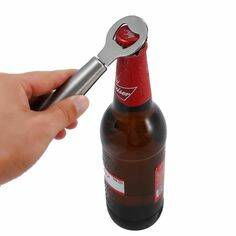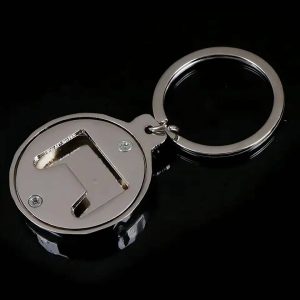General characteristics
A bottle opener is a small tool that is used to remove the metal caps or tops of bottles. Some general characteristics of bottle openers are:
- Compact size: Bottle openers are usually small in size and can be easily carried around in pockets or attached to keychains.
- Durable material: Most bottle openers are made of sturdy materials such as stainless steel or aluminum that can withstand repeated use.
- Simple design: Bottle openers typically have a simple design with a flat surface and a hook or lever used to pry open the bottle cap.
- Versatility: Bottle openers can be used to open a wide range of bottles such as beer bottles, soda bottles, and even some wine bottles.
- User-friendly: Bottle openers are easy to use and do not require any special skills or training to operate.
- Affordable: Bottle openers are relatively inexpensive and can be purchased at most grocery stores, convenience stores, or online retailers.
Overall, bottle openers are a convenient and essential tool for anyone who enjoys drinking bottled beverages.
About the basis of manufacturing and types of openers
he manufacturing of bottle openers typically involves cutting, shaping, and finishing a durable material such as stainless steel or aluminum into a compact tool that can be used to remove bottle caps. The manufacturing process may also involve adding features such as grips or decorative elements to the bottle opener.
There are several types of bottle openers available on the market. Here are some of the most common types:
1. Wall-mounted bottle opener: These bottle openers are designed to be mounted on a wall or other flat surface, and typically have a flat surface with a lip or lever that is used to open the bottle.
Wall-mounted bottle openers are often found in bars or restaurants, but can also be used in homes or outdoor entertaining areas. They are convenient because they can be easily accessed and do not require any additional setup or storage space.
Wall-mounted bottle openers come in a variety of styles and designs, ranging from simple and utilitarian to decorative and ornate. Some may feature logos or designs related to a particular sports team or brand, while others may have a more rustic or vintage look.
To use a wall-mounted bottle opener, simply place the bottle cap under the lip or lever and pull up on the bottle to remove the cap. The cap will typically fall into a receptacle located below the opener, making it easy to collect and dispose of the caps after use.
2. Handheld bottle opener: Handheld bottle openers are small, portable tools that can be easily carried in a pocket or attached to a keychain. They typically have a flat surface with a hook or lever used to pry open the bottle cap.
Handheld bottle openers are commonly used at home, at parties, and at outdoor events such as picnics or camping trips. They are simple and easy to use, and require minimal effort to remove a bottle cap.
Handheld bottle openers come in a variety of styles and designs, ranging from basic and utilitarian to decorative and personalized. Some may feature a soft grip or rubberized handle for added comfort and ease of use, while others may incorporate additional tools such as a can opener or corkscrew.
To use a handheld bottle opener, simply place the hook or lever under the edge of the bottle cap and lift up to remove the cap. Some bottle openers may include a magnet or other feature to catch the removed cap and prevent it from falling on the floor. After use, the bottle opener can be easily stored in a drawer, hung on a hook, or attached https://www.buydo.eu to a keychain for convenient access.
3.Waiter’s corkscrew: This type of bottle opener is specifically designed for removing corks from wine bottles. It typically includes a small knife for removing the foil wrapper, a corkscrew for removing the cork, and a lever for pulling the cork out of the bottle.
Waiter’s corkscrews are commonly used by waiters and sommeliers in restaurants, as well as by wine enthusiasts at home. They are compact and portable, and can be easily carried in a pocket or wine bag.
To use a waiter’s corkscrew, first remove the foil wrapper from the top of the wine bottle using the small knife. Then, insert the corkscrew into the center of the cork and twist it clockwise until the entire screw is inserted into the cork. Use the lever or fulcrum to pull the cork out of the bottle, twisting it gently to release the cork from the screw.
Waiter’s corkscrews come in a variety of styles and designs, ranging from basic and utilitarian to decorative and personalized. Some may feature additional tools such as a bottle opener or foil cutter, while others may be made from high-end materials such as stainless steel or carbon fiber.
4.Twist-off bottle opener: Some bottle caps are designed to be twisted off by hand, but a twist-off bottle opener can make the process easier and less messy. This type of bottle opener typically has a flat surface with a circular cutout that matches the size of the bottle cap.
A twist-off bottle opener typically consists of a flat metal surface with a circular cutout that matches the size of the bottle cap. The cutout is lined with small ridges or teeth that grip the cap as it is twisted, providing a secure and stable grip.
Twist-off bottle openers are commonly used at home, at parties, and at outdoor events such as picnics or camping trips. They are simple and easy to use, and require minimal effort to remove a bottle cap.
To use a twist-off bottle opener, simply place the circular cutout over the top of the bottle cap and twist it counterclockwise. The teeth on the inside of the cutout will grip the cap and allow it to be easily removed from the bottle. After use, the bottle opener can be easily stored in a drawer or hung on a hook for convenient access.

5.Electric bottle opener: Electric bottle openers use a motor to remove the bottle cap automatically. They are typically larger and more expensive than other types of bottle openers, but can be useful for people with limited hand strength or mobility.
Electric bottle openers are convenient and easy to use, and can be operated with the touch of a button. They are commonly used at home and in restaurants, and are especially useful for individuals with limited hand strength or mobility.
To use an electric bottle opener, first place the device on top of the bottle with the corkscrew or cap remover centered on the cap. Hold the bottle steady and press the button to activate the motor, which will rotate the corkscrew or cap remover and remove the cap from the bottle. Some models may also include a built-in foil cutter for removing the foil wrapper from the top of the bottle.
Electric bottle openers come in a variety of styles and designs, ranging from basic and utilitarian to sleek and modern. Some may include additional features such as a charging base, LED lights, or a digital display. After use, the device can be easily cleaned and stored for future use.
What to pay attention to in order to avoid mistakes when choosing
When choosing a bottle opener, there are a few important factors to consider in order to avoid making mistakes and selecting the wrong product. Here are some things to pay attention to:
- Type of bottle opener: Make sure you select a bottle opener that is appropriate for the type of bottle you will be opening. For example, if you primarily drink wine, a waiter’s corkscrew will be more useful than a wall-mounted bottle opener.
- Quality and durability: Look for a bottle opener that is made from high-quality materials and is built to last. Cheaper, low-quality bottle openers may break or wear out quickly with frequent use.
- Comfort and ease of use: Consider how comfortable and easy the bottle opener is to use. If you have limited hand strength or mobility, an electric or handheld bottle opener may be more suitable than a traditional wall-mounted opener.
- Additional features: Some bottle openers may include additional features such as a built-in foil cutter or can opener. Consider whether these features would be useful to you.
- Design and style: Bottle openers come in a variety of designs and styles, so choose one that reflects your personal taste and complements your home decor.
By paying attention to these factors, you can select a bottle opener that meets your needs and preferences, and avoid making mistakes when choosing a bottle opener.
Tips for care and operation
Proper care and operation of bottle openers can help ensure their longevity and effectiveness. Here are some tips:
- Clean your bottle opener regularly: Depending on the type of bottle opener, it may accumulate dirt, grime, or residue over time. Regularly cleaning your bottle opener will help keep it in good condition. For handheld and waiter’s corkscrew bottle openers, you can use soap and warm water. For electric and wall-mounted openers, use a damp cloth to wipe down the device.
- Keep your bottle opener dry: After cleaning, be sure to dry your bottle opener thoroughly. Moisture can cause rust or other damage to metal components, so it is important to avoid leaving your bottle opener wet.
- Store your bottle opener in a safe place: When not in use, store your bottle opener in a place where it will not be damaged or lost. Wall-mounted bottle openers can be hung on a hook or mounted on a wall. Handheld and waiter’s corkscrew bottle openers can be stored in a drawer or wine bag. Electric bottle openers can be stored on their charging base.
- Follow the manufacturer’s instructions: Depending on the type of bottle opener, there may be specific instructions for use and care. Be sure to read and follow the manufacturer’s instructions to ensure proper operation and avoid damage to the device.
- Use the bottle opener properly: To avoid damage to the bottle opener or injury, be sure to use it properly. For example, when using a waiter’s corkscrew, insert the screw into the center of the cork and twist gently. For electric and wall-mounted openers, be sure to align the device with the bottle cap or cork before activating the motor.
By following these tips, you can keep your bottle opener in good condition and ensure it continues to function effectively.
